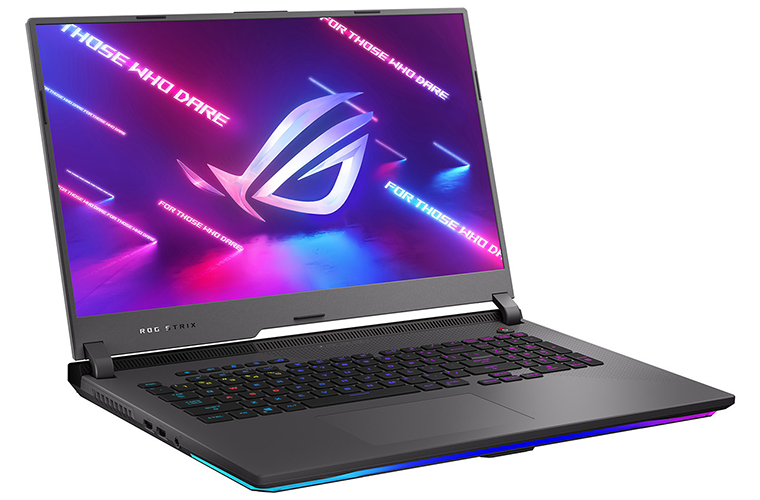Introduction
Build a compelling CPU architecture and system integrators will come. That's certainly true of AMD Zen, which slowly but surely is proving pervasive in every major PC category. Ryzen has transformed the firm's desktop CPU fortunes, mobile Ryzen is popping up in all the latest ultra-thin laptops, and even the server space - a traditional Intel stronghold - is responding kindly to AMD Epyc.
Can Ryzen crack the gaming laptop arena, too? We see no reason why not, and if the Asus ROG Strix G17 G713Q is anything to go by, gamers can look forward to tantalising combinations of AMD Ryzen 5000 Series CPUs and Nvidia GeForce RTX 3000 Series graphics.
Asus' website suggests a multitude of configurations will be available, varying from one region to the next, but here on UK shores it is the G713QR-HG026T that catches the eye. Finished in grey and priced at £1,900, the 17in powerhouse purports to offer plenty of bang for your buck, and for a gaming solution, it is reasonably sleek in appearance. Granted, the RGB light bar across the front edge doesn't do a lot for us, but it is inoffensive while the patterned top lid and backlit ROG logo actually adds a nice touch of flair.
We appreciate that the overall design is a little less gaudy than the dearer Scar 17, and the grey paintwork does a decent job of repelling fingerprints. Build quality is decent enough, too, for a chassis incorporating its fair share of plastic, and though there is some noticeable flex, the large 395mm x 282mm x 28.3mm footprint is firmly planted on thick rubber feet allowing for the lid to be pushed back to around 130° using one hand.
The angular edge below the display panel strikes us as odd - so much so that we no longer help but notice it - and though Asus has reduced the number of gamer-oriented flourishes compared to the aforementioned Scar, there's still room for further improvement. We'd rather repurpose the dedicated ArmoryCrate shortcut key for something more useful, the red LED on the power button could be deemed somewhat distracting, and the shrill sound effect at boot makes me jump out of my skin each time I restart. That awful sound can thankfully be disabled in BIOS.
Unnecessary frills aside, the laptop gets plenty right for the target audience. The thin-bezelled 17.3in 1080p IPS-like (né VA) panel, from Sharp, offers a matte finish, decent viewing angles, and importantly for pro gamers, a super-fast 300Hz refresh rate that bodes well for silky-smooth gameplay.
Driving those pixels, the main body is outfitted with an eight-core AMD Ryzen 9 5900HX processor, 16GB of DDR4-3200 memory, a 1TB SK hynix M.2 SSD and GeForce RTX 3070 Laptop 8GB graphics. One advantage of the 17.3in form factor is that high-end components have more room to breathe. The 45W AMD Ryzen chip is able to maintain healthy all-core speeds under load, and the Nvidia GPU, which as we know can offer wildly variable performance depending on implementation, is offered in a 115W configuration, rising to 130W with Dynamic Boost. We should, therefore, be looking at RTX 3070 Laptop close to its very best.
Supporting those potent core components is a 90Wh battery that provides surprisingly good longevity (more on that later), Wi-Fi 6 connectivity, and downward-firing stereo speakers that make up for a lack of bass with decent clarity and a surprising amount of volume.
We've managed to get on quite well with the full-size, rubber-dome keyboard - despite the awkwardly small arrow keys - and though the integrated buttons on the trackpad are loud during use, the smooth surface is large and responsive.
Strix G17 feels a comfortable place for both work and play, and there's a decent selection of connectivity for either use-case. The laptop's left side is home to a pair of USB 3.2 Gen 1 Type-A and a combination audio jack, and every other port is neatly tucked around back. Here's where you'll find another USB 3.2 Gen 1 Type-A, a USB 3.2 Gen 2 Type-C with DisplayPort, full-size HDMI, an Ethernet jack and a connector to the external 240W power supply.
It's a shame Asus didn't include a card reader - there's clearly room on the laptop's right side - but the more pressing concern is the absence of a webcam or any form of biometric security. This isn't the first Asus laptop to forego a built-in camera, but on a chassis of this size, the decision to go without feels all the more peculiar. There's also a fair amount of bloatware to contend with, and users who appreciate a clean install will want to flatten the 64-bit Windows 10 Home at the earliest opportunity.
Presentation and usability are about right for a £1,900 gaming laptop. Question is, can the 45W Ryzen CPU and 115W GeForce GPU deliver the requisite punch? Let's run the benchmarks and find out.












